Making Mooncakes
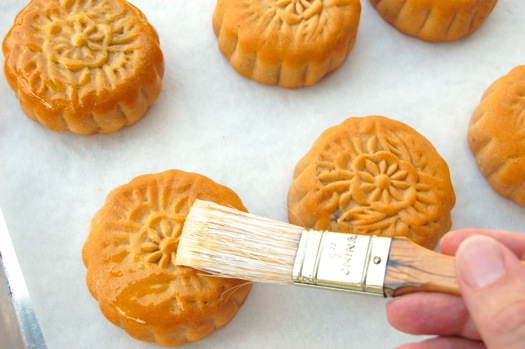
I could really get addicted to these. They’re like little sweet potato pies with a slightly salty, eggy reward in the center. I’ve come to the conclusion that mooncakes are best when they aren’t too sweet. Canned adzuki bean paste tends to be extremely sweet, so I urge you to try making your own. You’ll be far more satisfied with the taste of your cakes. Also, since the key to a successful mooncake is getting your component textures right, you’ll have far more control.
Start by gathering your components. To make the dough for the outer crust, combine your syrup, oil, soda and alkaline water in a bowl.

Stir. It’ll get a bit lumpy as the soda reacts with the acidic syrup and makes bubbles. Not to worry.
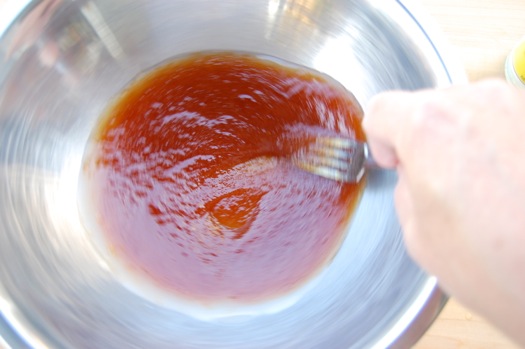
Sift on the cake flour…

…and stir gently with a fork to incorporate it.
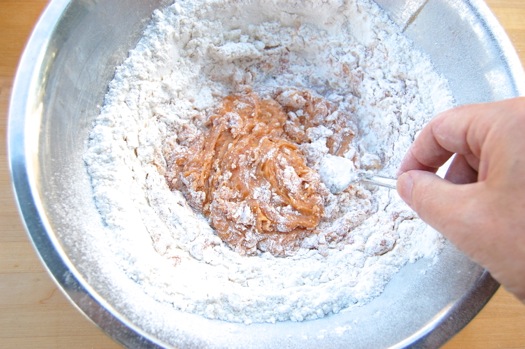
Bring it all together into a thick dough. The consistency will remind you of a chewy caramel. Let it sit in the fridge for at least four hours or overnight. It will keep for up to three days.
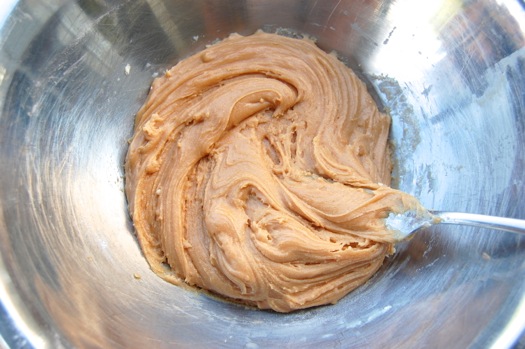
Next, cook your salted yolks. The easiest way to do these is to steam them for about ten minutes. You can also bake them in a 300-degree Fahrenheit oven for 10-15 minutes. Just be careful not to dry them out.

Cooked! Set these aside (in the fridge if you like) until you’re ready to use them.
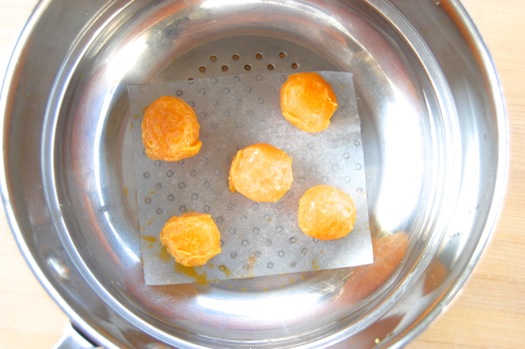
So then, the shaping. You’ll need a small bowl of vegetable oil and a small plate of flour, so get those ready. Since each mooncake mold is a little different, you’ll need to experiment a bit at the beginning. My larger one will hold about 3.75 ounces of filling plus a salted yolk. This ball is a little light. More bean paste, dink!
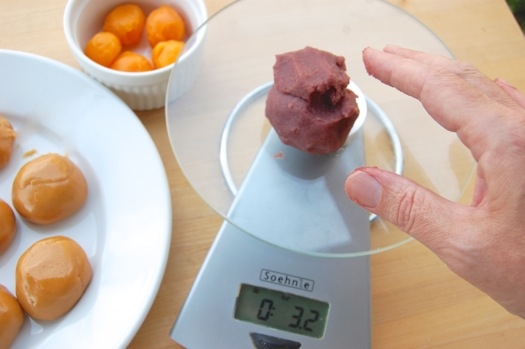
So once I’ve got my adzuki paste ball weighed out, I’ll enclose a cooked yolk in it…
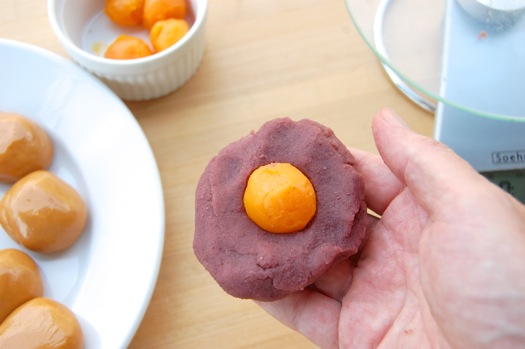
…like so. Maybe smooth those holes over.

Now for the skin. As a general rule the weight of the crust should be about a third of the total filling weight. A salted yolk weighs about half an ounce added to 3.75 ounces of filling. That’s 4.25 ounces divided by four…so I need an ounce of crust dough for each cake.
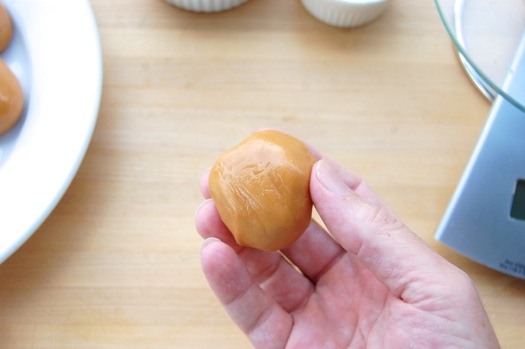
Begin the shaping process by making the dough ball into a disk. Pinch the outer rim of the disk so it’s quite a bit thinner than the center. This is important since the disk will stretch from the center outward as you shape. The dough should just barely hold its shape as you do this. If it’s too slack, work in some more flour until it stiffens a bit but is still very plastic.
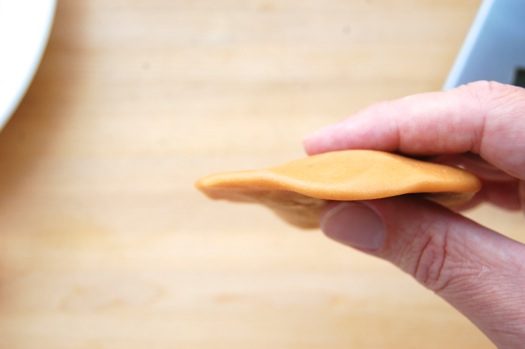
Plop the filling ball in the middle. Plop.
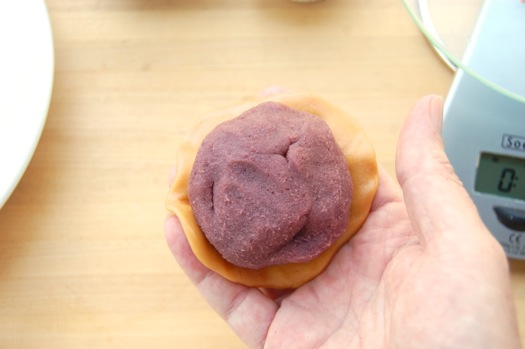
Now flip it over into the opposite hand, filling down. Dip your fingers in the vegetable oil and rub it over the dough.
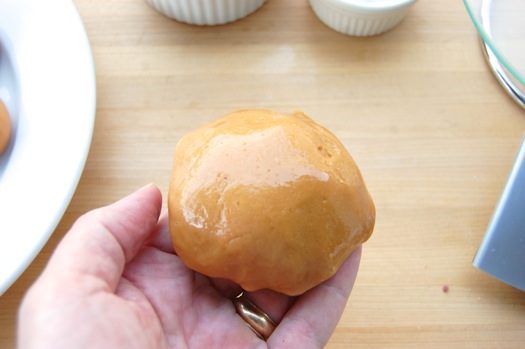
Flip the ball back over into the oily hand. You’re worried now that you’re going to screw this whole thing up. So take a deep breath and have a good laugh at your own expense. Next, start rotating the ball in your hand, clockwise or counter clockwise is up to you, just play a little. As you do that you’ll notice that dough is magically creeping up the sides of the ball.
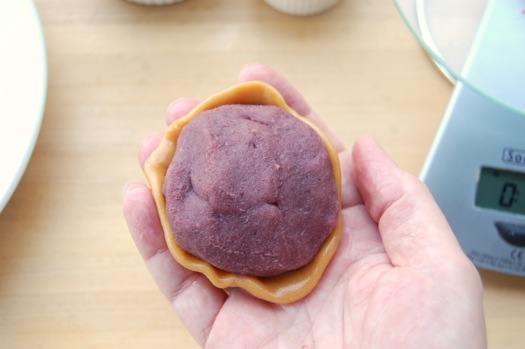
Help it along by gently pulling with the fingers of the other hand. You can see the progress I’m making here, looking at the ball from the side. Imagine you’re throwing a pot on a wheel. That’s sort of what this process is like. (Other hand not shown because it’s busy snapping pictures).
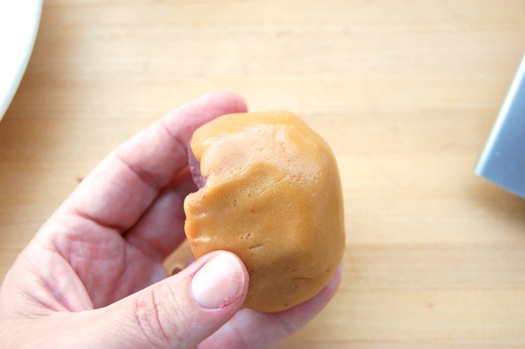
Pull the dough some and pinch the top edges as you rotate the ball with the oily hand.

Before you know it the ball is enclosed. If there are any torn spots in it, just squeeze them together since this dough is as you’ve seen quite stretchy. My seams are still a little messy, but then I’m a newbie.
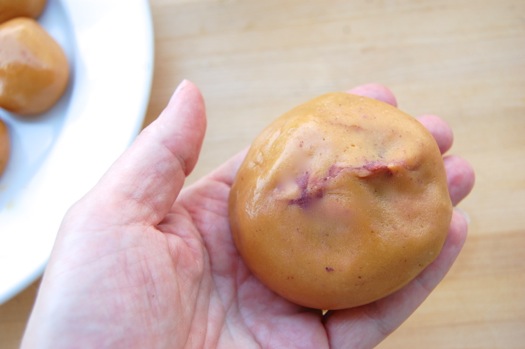
Now wipe your hands on a nearby towel. Dab them in flour…
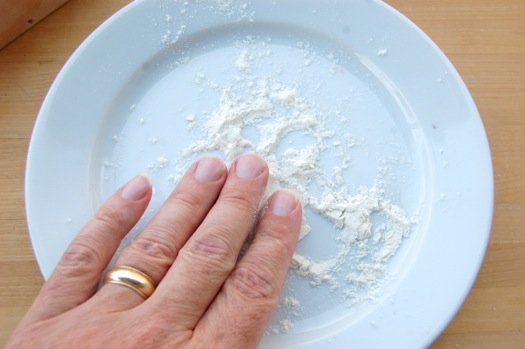
…and pat it lightly all over the ball. This will prevent sticking during the final shaping step.
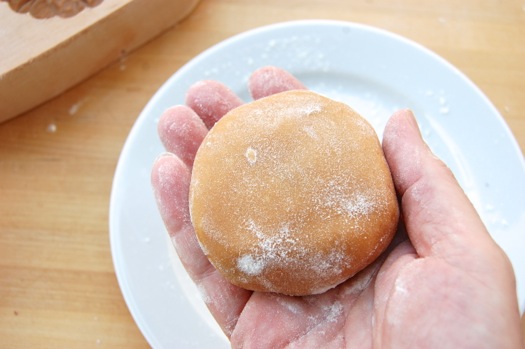
So then. Seizing the nearest available mooncake mold…
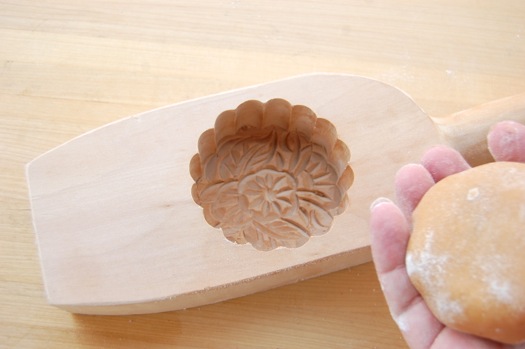
…press the cake into it, seam-side up. Press it in firmly.
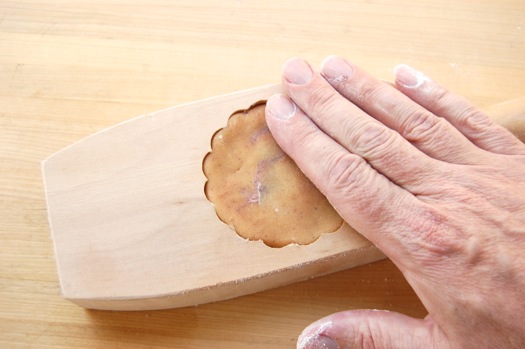
To turn it out, gently tap the mold on the counter until you see a little gap as the cake releases. Do this on all sides…
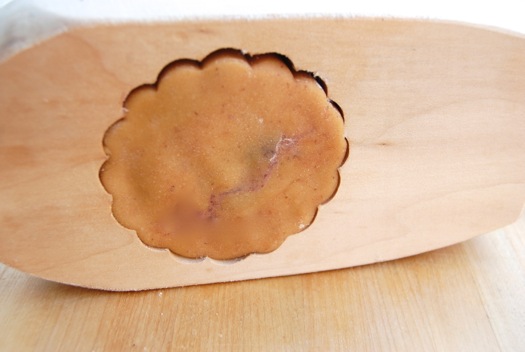
…then up-end the mold onto a sheet pan or into your hand.
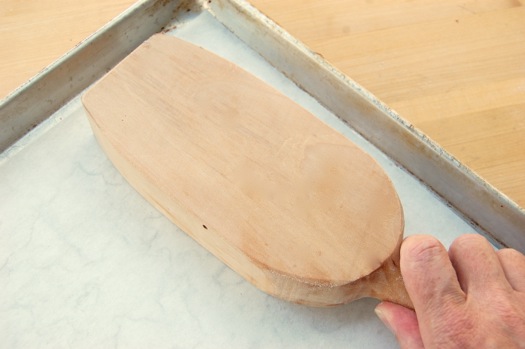
There. Ready to bake! Repeat with the remaining filling and dough. You can pre-make filling and dough balls to speed the process along if you like and keep them refrigerated, though you want to bring them up to room temperature before you shape. Preheat your oven to 400 degrees Fahrenheit.
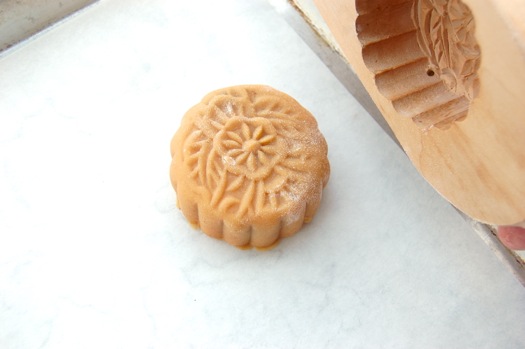
Let the finished cakes sit for at least half and hour and up to an hour before baking to relax any activated gluten, which would cause shrinking and a loss of your lovely pattern. Spritz a little water on the cakes to prevent drying and cracking.

Now here’s where I made my mistake. I baked them too long. I let these go for 12 minutes, which was just about perfect, however I failed to apply my egg wash along the way. Here I’m painting it on at the 12 minute mark.

I baked about 8 minutes more and that was my error. Why? Because as the interior filling gets hot it generates steam. That steam causes the dough to stretch and “erases” the delicate pattern on the top.
This need not be the case. The interior is already cooked, so it doesn’t need to heat all the way through. All you need to do is brown the outer crust and you’re done for all intents and purposes. Here’s what happened after a further 8 minutes:
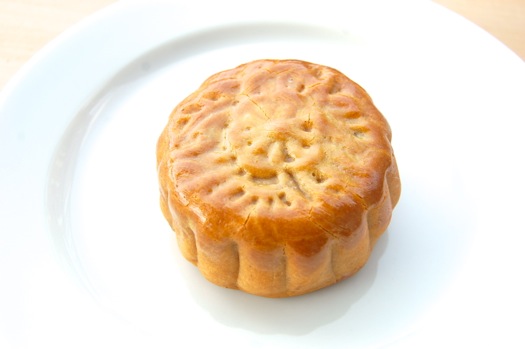
Not terrible, but I should have stopped earlier. Next time I’ll bake them for six minutes, apply egg wash and bake another six or so until they’re golden. You can see from this cross-section that the crust is overdone. Too brown, too brittle.
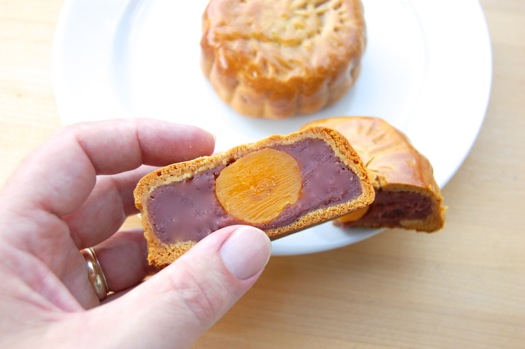
Still, not bad for a lo fan from Kentucky, eh? There’s the harvest moon in my evening sky…and is it ever delicious! I see why people make double and triple yolkers. They really are excellent. Happy Mid-Autumn Festival to all!
Well done Joe!
They look great.
Peter
Thanks Peter. I’m as surprised as anyone. These aren’t as scary as they seem. Getting the dough and filling to the right consistency is the key. After that they come together fairly easily. Thanks for checking in!
– Joe
You are intrepid and have amazing skills to match your sense of adventure! I am beyond impressed and I wonder if you will ever run out of things to bake!
Did you have to do anything to prepare the mold to release the cakes?
Ha! You silver-tongued devil, you! Thanks, Rainey. I had fun with these and let them stress me out only occasionally. They’re not as hard as they might seem, though I’ll say that just as with other pastries that have components that need full attention, it’s best to tackle one piece a day over about a week. Oh, and make extra for the flubs!
I’m going to make a whole bunch for Mrs. Pastry’s Chinese colleagues next week for the Mid-Autumn Festival and gauge their reaction.
Regarding the mold, I didn’t prep it in way way. It’s uncoated wood and works great just the way it is!
– Joe
I became a passionate gourmand by inspiration of my PoPo (grandmother) and father who, every time they entered the kitchen, produced such delicious and memorable family Cantonese meals. You’re one Lo Fan they’d be proud of. Thanks for inspiring me with your earnest and beautiful creation!
OCB, you made my day!
– Joe
Wow, very impressive Joe L?osh?! They are beautiful out of the mold!
I am using your technique for “complicated” pastries today, making one component per day until the final construction day. Today is assembling brioche Polonaise day for me for a small gathering tonight.
Good luck Dave! I want photos! 😉
– Joe
Hi Joe,
All I can say is “Wow”! I live in Hong Kong and have loved mooncakes all my life. I consider myself a fairly accomplished baker, but I would never, ever have even dreamed of trying to make them although all the ingredients are easily available. So, hats off to you. The mooncakes look gorgeous! You are truly a master baker. Have you thought of trying laminated brioche? I understand it gives “Cronuts” a run for its money.
Hi Bina! What a wonderful, flattering email. I’m going to be impossible to deal with all day as a result of it. I’ll be taste testing these with people who really know mooncakes next week. I hope they’ll pass muster.
When you say “laminated brioche” do you mean the Migoya recipe? Talk about decadence. I love making laminated doughs though. So perhaps I shall. Thanks for the suggestion!
– Joe
Joe, I love these! I’ve never considered making my own, but now I think I have to. Will you stop at red bean, or will you try some of the more contemporary flavors?
Hello Lonely Noodle! Wonderful blog you have. You make such delightful things.
And thanks so much! I probably won’t go on to other fillings, at least not this year! I’m so enamored with these I will absolutely make them again. Any suggestions?
– Joe
Hi Joe,
Thank you so much for the compliment! For traditional flavors, I think lotus seed paste is probably my favorite (more than red bean, which I also love). But tonight I ate a snow-skinned mooncake with hami melon, passionfruit and mango. It was pretty delicious. I think next year I’ll have to try making my own mooncakes just so I can experiment with flavors!
Wow, do those sound good. Thanks for the great ideas, Sherry!
– Joe
I don’t know that I’ll ever make these but really enjoyed reading and viewing the photos of your step by step. I do love eating them!!
Thanks, Kavey! I had a good time making them. Only on occasion did they make me nervous. 😉
– Joe
wow a white guy making moon cake…hats off to you.
Durian filling moon cake is a hit here in Malaysia.
Thank you, Ju! I’m interested in trying other fillings one of these days. I admit that Durian worries me a little. 😉
– Joe
They look wonderful! Good job!
Thank you, Rosie!
Looks fantastic!
Thanks GC! They’re not a conventional pastry taste by Western standards, but I’ve already developed a taste for these. There will be more in the future!
– Joe
Hi Joe,
I am….blown away. Seeing as how the Mid-Autumn Festival is just about a week away and we recently bought our own box of moon cakes (we’re Chinese, if you couldn’t tell), I pulled my mom into the room to show her what you made, by *hand*, and she was also quite blown away. Well done, sir, well done! *applauds*
April
Haha! Thanks, April, that means a lot. I’ll say they had me worried at points. Obtaining and refining all the different components was a challenge, but I was surprised at how easy the actual shaping turned out to be once I had everything together. I often say that you must not fear the pastry. I don’t always heed my own advice, but in this case it worked well. Thanks again and have a terrific holiday!
– Joe
Oh my God these are perfect! And you’ve added so much detail about the process! I can now see where I’ve been doing things ALL WRONG each time I’ve tried to make them. You’ve inspired me to try again, thank you so much Joe!
Justine, it does my heart good to hear you’re satisfied. I was worried there for a second! As you probably noticed I discovered a couple of possible reasons why the top patterns fade during baking. I hope this helps!
Cheers,
– Joe
Beautiful!
Thanks Arthur!
– Joe
This is amazing. Who knew you could make these at home!
They were fun, Ila! Try them when you get a chance. You can fill them with just about anything as long as it’s the same consistency!
Cheers,
– Joe
Hi Joe,
Your mooncakes look beautiful! I was searching online for molds and patterns available and came across “Full Moon” Cakes made in a bakery in Singapore/Hong Kong that made me laugh! Slightly NSFW because “15th day of 8th Month” also means buttocks in the Cantonese dialect! I am shy to leave a link here in case you or your readers object, but the play on words is clever because it also works in English and it just cracked me up! 🙂
Ha! Sure, G, go ahead. And you’re right we have a similar turn of phrase in English. To “moon” someone is to show them your rear end. Didn’t know the same thing sort-of applied in Cantonese. Nice to know some things are universal! 😉
– Joe
There you go!
http://redcook.net/2009/09/28/commercialization-moon-festival/
Woohoo! Happy mid-Autumn Festival! Even though it’s still summer by our calendar. 😉
– Joe
True, and still way too warm here in CA!! Autumn is quite, quite far still!
Hi Joe! Just wanted to say your mooncakes look amazing!! I’d love to try making them but who am I kidding – mine would never come out as beautiful as yours did! I admire your skills, and your “lo fan” comment had me laughing out loud!
I’m originally from Hong Kong and we’re enjoying our boxed mooncakes right now…even my 8 year old loves them. It’s great to see you have so much success with your homemade creation. Kudos to you! : )
Monica, I thank you. But I wish you would try them since they really aren’t all that difficult. I have orders for next year from some of Mrs. Pastry’s Chinese colleagues over at the university. They paid criminal sums for theirs this year…over thirty dollars for only four! I could go into business here in Louisville and make a fortune! The Cantonese crowd liked the bean paste, but others requested lotus paste, which I hope to try one of these days. This is really a fascinating pastry with all sorts of potential variations. Thank you for the encouragement. Soon I may be the mooncake king of Kentucky!
Cheers and your shrimp with lobster sauce looks amazing. I will make it this week since it’s my favorite carry out Chinese dish!
– Joe
Awww…thanks for checking out the shrimp and lobster sauce, Joe!
I can totally see you as Mooncake King of Kentucky! : ) Your mooncakes look truly professional. I’m Cantonese and I love bean paste but I can honestly only remember eating the lotus paste variety when it comes to mooncake – I thought that was the standard but what do I know! I’ve always been told that the gold standard for mooncakes is the one made by a company called “Wing Wah”…we buy those every year and the going rate here in the NY/NJ area for a box is over $40! My family and I keep wondering why it’s so expensive! Luckily, my sister scored us some for the “bargain” price of $32 a box! : )
Take care!
Thanks Monica!
I was at a party last Friday night and some Chinese folks I met there told me that traditional fillings vary from place to place. A fellow from Canton also talked about lotus paste. I’ll have to try that one next year (or maybe sooner…I may need to start an R&D department!).
– Joe
Saw this in the news and thought you’d find it interesting:
http://www.theatlantic.com/china/archive/2013/09/the-surprising-economics-of-mooncakes-an-infographic/279839/
It discusses just how much of the cost of producing a mooncake goes into its packaging – it’s crazy.
No wonder they’re so darn expensive!
Thanks Catherine!
– Joe
DUDE LOL are you married to an Asian? How do you know the word lo fan. I was surprised to see you had Japanese version of cheesecake as well as moon cakes. You are a great baker and I love reading your posts!
Judy, I’ve been around the world and have been called everything in the book at one time or another! What else can I say?
But thanks for the very kind words. I generally do what my readers ask me to do…which is why I’m so eclectic! 😉
Cheers,
– Joe
Lovely to find your recipe, and your instructions. I never thought I the wrapping process could be so much fun! I added some black sesame paste to the filling, and its oil seemed to help give them the right consistency.
I found your site as I looked up help for dobos torta. Having lived in Budapest, we always loved them, and without your help, don’t know if I’d had a go. The results were fantastic!
Thank you so much for sharing these.
Hello Kay,
I was looking through these comments and found this comment from last year that I never replied to! Very sorry for that since I try to acknowledge everyone who gets in touch. Did you make mooncakes this year?
And nice to know you had such success with the dobos torte! Come back soon!
– Joe
Hi, it’s amazing you attempt to make mooncakes over in Kentucky. Here in Malaysia, it’s readily available in stores and many of us don’t bother to make them. Those of us who do, only make it to avoid paying the ridiculous retail prices.
For your information, lotus paste and red bean paste are both used as mooncake fillings. The former is however considered more premium, more delicious and commands a higher retail price. The latter is considered lower class and consequently the vast majority of mooncakes sold are filled with lotus paste.
Very interesting. If I can find lotus paste I shall fill my next mooncakes with it. Thank you very much, Huai Chien!
– Joe